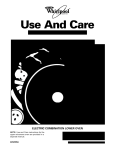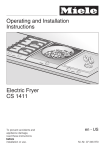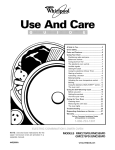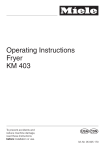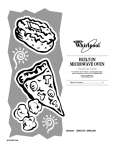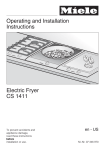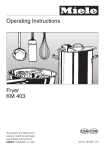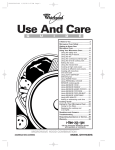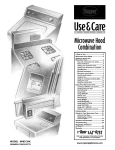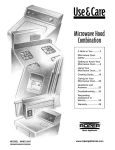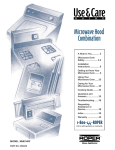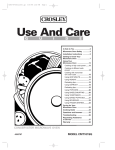Download Whirlpool RMC275PD Microwave Oven
Transcript
Use And Care G U I D E A Note to You ..........................................2 Microwave Oven Safety .........................3 Getting to Know Your Microwave Oven .....................................6 Using Your Microwave Oven ...............10 Using ADD MINUTE ............................10 Using COOK A BIT MORE ..................10 Using MEMORY...................................11 Cooking at high cook power ................12 Cooking at different cook powers ........13 Cooking in stages ................................14 Reheating food ....................................15 Defrosting ............................................17 Defrosting tips......................................19 Popping popcorn .................................19 Using AUTO COOK .............................20 Auto cook code chart...........................20 Baking potatoes...................................22 Heating a beverage .............................22 Using WARM HOLD ............................23 Using code pads..................................24 Cooking Guide ......................................25 MICRO TIME chart ..............................25 Microwave cooking tips .......................26 Caring for Your Microwave Oven ........28 Questions and Answers.......................29 Troubleshooting....................................30 Requesting Assistance or Service......31 Warranty ................................................32 Call our Consumer Assistance Center with questions or comments. 1-800-253-1301 UPPER MICROWAVE OVEN NOTE: Use and care instructions for the lower oven are provided in a separate manual. 4452005A MODELS RMC275PD/RMC305PD GMC275PD/GMC305PD A Note to You Thank you for buying a Whirlpool® appliance. The Whirlpool Brand is committed to designing quality products that consistently perform for you to make your life easier. To ensure that you enjoy years of trouble-free operation, we developed this Use and Care Guide. It is full of valuable information about how to operate and maintain your appliance properly. Please read it carefully. Also, please complete and mail the Product Registration Card provided with your appliance. The card helps us notify you about any new information on your appliance. Please record your model’s information. Whenever you call to request service for your appliance, you need to know your complete model number and serial number. You can find this information on the model and serial number label/plate (see diagram in the “Parts and Features” section). Please also record the purchase date of your appliance and your dealer’s name, address, and telephone number. Model Number Serial Number Purchase Date Dealer Name Dealer Address Dealer Phone Keep this book and the sales slip together in a safe place for future reference. It is important for you to save your sales receipt showing the date of purchase. Proof of purchase will assure you of in-warranty service. Our Consumer Assistance Center number is toll free. 1-800-253-1301 To find detailed product information, the location of the nearest Whirlpool dealer or designated servicer, to purchase an accessory item, or register your appliance on-line, please visit our Web site at www.whirlpool.com 2 Microwave Oven Safety Your safety and the safety of others is very important. We have provided many important safety messages in this manual and on your appliance. Always read and obey all safety messages. This is the safety alert symbol. This symbol alerts you to hazards that can kill or hurt you and others. All safety messages will be preceded by the safety alert symbol and the word “DANGER” or “WARNING.” These words mean: wDANGER You will be killed or seriously injured if you don’t follow instructions. wWARNING You can be killed or seriously injured if you don’t follow instructions. All safety messages will identify the hazard, tell you how to reduce the chance of injury, and tell you what can happen if the instructions are not followed. IMPORTANT SAFETY INSTRUCTIONS When using electrical appliances basic safety precautions should be followed, including the following: WARNING: To reduce the risk of burns, electric shock, fire, injury to persons or exposure to excessive microwave energy: • Read all instructions before using the microwave oven. • Read and follow the specific “PRECAUTIONS TO AVOID POSSIBLE EXPOSURE TO EXCESSIVE MICROWAVE ENERGY ” found in this section. • As with any appliance, close supervision is necessary when used by children. • Do not operate the microwave oven if it has a damaged cord or plug, if it is not working properly, or if it has been damaged or dropped. containers – for example, closed glass jars – may explode and should not be heated in the microwave oven. • Do not immerse cord or plug in water. • Keep cord away from heated surfaces. • Do not let cord hang over edge of table or counter. • The microwave oven should be serviced only by qualified service personnel. Call an authorized service company for examination, repair or adjustment. • The microwave oven must be grounded. Connect only to properly grounded outlet. See “GROUNDING • Do not cover or block any openings on the microwave oven. INSTRUCTIONS” found in this section. • Do not store the microwave oven outdoors. Do not • Install or locate the microwave oven only in use the microwave oven near water – for example, accordance with the provided installation near a kitchen sink, in a wet basement, or near a instructions. swimming pool, and the like. • Some products such as whole eggs and sealed • Use the microwave oven only for its intended use as described in this manual. Do not use corrosive chemicals or vapors in the microwave oven. This type of oven is specifically designed to heat, cook, or dry food. It is not designed for industrial or laboratory use. • See door surface cleaning instructions in the “Caring for Your Microwave Oven” section. • Do not mount over a sink. • Do not store anything directly on top of the microwave oven when the microwave oven is in operation. SAVE THESE INSTRUCTIONS 3 MICROWAVE OVEN SAFETY IMPORTANT SAFETY INSTRUCTIONS • To reduce the risk of fire in the oven cavity: – Do not overcook food. Carefully attend the microwave oven if paper, plastic, or other combustible materials are placed inside the oven to facilitate cooking. – Remove wire twist-ties from paper or plastic bags before placing bag in oven. – If materials inside the oven should ignite, keep oven door closed, turn oven off, and disconnect the power cord, or shut off power at the fuse or circuit breaker panel. – Do not use the cavity for storage purposes. Do not leave paper products, cooking utensils, or food in the cavity when not in use. SAVE THESE INSTRUCTIONS PRECAUTIONS TO AVOID POSSIBLE EXPOSURE TO EXCESSIVE MICROWAVE ENERGY (a) Do not attempt to operate this oven with the door open since open-door operation can result in harmful exposure to microwave energy. It is important not to defeat or tamper with the safety interlocks. (b) Do not place any object between the oven front face and the door or allow soil or cleaner residue to accumulate on sealing surfaces. Electrical requirements Observe all governing codes and ordinances. A 240 Volt, 60 Hz, AC only, 20 amp fused electrical supply is required. (A time-delay fuse is recommended.) It is recommended that a separate circuit serving only this appliance be provided. 4 (c) Do not operate the oven if it is damaged. It is particularly important that the oven door close properly and that there is no damage to the: (1) Door (bent), (2) Hinges and latches (broken or loosened), (3) Door seals and sealing surfaces. (d) The oven should not be adjusted or repaired by anyone except properly qualified service personnel. MICROWAVE OVEN SAFETY GROUNDING INSTRUCTIONS • For all cord connected appliances: The microwave oven must be grounded. In the event of an electrical short circuit, grounding reduces the risk of electric shock by providing an escape wire for the electric current. The microwave oven is equipped with a cord having a grounding wire with a grounding plug. The plug must be plugged into an outlet that is properly installed and grounded. WARNING: Improper use of the grounding plug can result in a risk of electric shock. Consult a qualified electrician or serviceman if the grounding instructions are not completely understood, or if doubt exists as to whether the microwave oven is properly grounded. Do not use an extension cord. If the power supply cord is too short, have a qualified electrician or serviceman install an outlet near the microwave oven. • For a permanently connected appliance: The microwave oven must be connected to a grounded, metallic, permanent wiring system, or an equipment grounding conductor should be run with the circuit conductors and connected to the equipment grounding terminal or lead on the microwave oven. SAVE THESE INSTRUCTIONS 5 Getting to Know Your Microwave Oven This section discusses the concepts behind microwave cooking. It also shows you the basics you need to know to operate your microwave oven. Please read this information before you use your oven. How your microwave oven works For the best cooking results Microwave energy is not hot. It causes food to make its own heat, and it’s this heat that cooks the food. Microwaves are like TV waves, radio waves, or light waves. You cannot see them, but you can see what they do. A magnetron in the microwave oven produces microwaves. The microwaves move into the oven where they contact food as it turns on the turntable. The glass turntable of your microwave oven lets microwaves pass through. Then they bounce off a metal floor, back through the glass turntable, and are absorbed by the food. • Always cook food for the shortest cooking time recommended. Check to see how the food is cooking. If needed, touch ADD MINUTE while the oven is operating or after the cooking cycle is over (see the “Using ADD MINUTE” section). • Stir, turn over, or rearrange the food being cooked about halfway through the cooking time for all recipes. This will help make sure the food is evenly cooked. • If you do not have a cover for a dish, use wax paper, or microwave-approved paper towels or plastic wrap. Remember to turn back a corner of the plastic wrap to vent steam during cooking. Magnetron Testing your microwave oven To test the oven put about 1 cup of cold water in a glass container in the oven. Close the door. Make sure it latches. Cook at 100% power for 2 minutes. When the time is up, the water should be heated. Metal floor Oven cavity Glass turntable Microwaves pass through most glass, paper, and plastics without heating them so food absorbs the energy. Microwaves bounce off metal containers so food does not absorb the energy. Radio interference Using your microwave oven may cause interference to your radio, TV, or similar equipment. When there is interference, you can reduce it or remove it by: • Cleaning the door and sealing surfaces of the oven. • Adjusting the receiving antenna of the radio or television. • Moving the receiver away from the microwave oven. • Plugging the microwave oven into a different outlet so that the microwave oven and receiver are on different branch circuits. 6 Testing your dinnerware or cookware Test dinnerware or cookware before using. To test a dish for safe use, put it into the oven with a cup of water beside it. Cook at 100% cook power for one minute. If the dish gets hot and water stays cool, do not use it. Some dishes (melamine, some ceramic dinnerware, etc.) absorb microwave energy, becoming too hot to handle and slowing cooking times. Cooking in metal containers not designed for microwave use could damage the oven, as could containers with hidden metal (twist-ties, foil lining, staples, metallic glaze or trim). GETTING TO KNOW YOUR MICROWAVE OVEN Operating tips • For best results, stir any liquid several times • Never lean on the door or allow a child to swing on it when the door is open. • Use hot pads. Microwave energy does not heat containers, but the heat from the food can make the container hot. • Do not use newspaper or other printed paper in the oven. • Do not dry flowers, fruit, herbs, wood, paper, gourds, or clothes in the oven. • Do not start a microwave oven when it is empty. Product life may be shortened. If you practice programming the oven, put a container of water in the oven. It is normal for the oven door to look wavy after the oven has been running for a while. • Do not try to melt paraffin wax in the oven. Paraffin wax will not melt in a microwave oven because it allows microwaves to pass through it. • Do not operate the microwave oven unless the glass turntable is securely in place and can rotate freely. The turntable can rotate in either direction. Make sure the turntable is correct-side up in the oven. Handle your turntable with care when removing it from the oven to avoid possibly breaking it. If your turntable cracks or breaks, contact your dealer for a replacement. • When you use a browning dish, the browning dish bottom must be at least 3⁄16 inch above the turntable. Follow the directions supplied with the browning dish. • Never cook or reheat a whole egg inside the shell. Steam buildup in whole eggs may cause them to burst, and possibly damage the oven. Slice hardboiled eggs before heating. In rare cases, poached eggs have been known to explode. Cover poached eggs and allow a standing time of one minute before cutting into them. • • • during heating or reheating. Liquids heated in certain containers (especially containers shaped like cylinders) may become overheated. The liquid may splash out with a loud noise during or after heating or when adding ingredients (coffee granules, tea bags, etc.). This can harm the oven. Microwaves may not reach the center of a roast. The heat spreads to the center from the outer, cooked areas just as in regular oven cooking. This is one of the reasons for letting some foods (for example, roasts or baked potatoes) stand for a while after cooking, or for stirring some foods during the cooking time. Do not deep fry in the oven. Microwavable utensils are not suitable and it is difficult to maintain appropriate deep-frying temperatures. Do not overcook potatoes. At the end of the recommended cooking time, potatoes should be slightly firm because they will continue cooking during standing time. After microwaving, let potatoes stand for 5 minutes. They will finish cooking while standing. Electrical connection If your electric power line or outlet voltage is less than 240 volts, cooking times may be longer. Have a qualified electrician check your electrical system. 7 GETTING TO KNOW YOUR MICROWAVE OVEN USING YOUR OVEN Microwave oven features 7 6 3 8 4 5 2 Your microwave oven is designed to make your cooking experience as enjoyable and productive as possible. To help get you up and running quickly, the following is a list of the oven’s basic features: 1. Door Handle. Pull to open door. 2. Window with Metal Shield. Shield prevents microwaves from escaping. It is designed as a screen to allow you to view food as it cooks. 3. Cooking Guide Label. Use as a quick reference for Cook settings. 4. Glass Turntable. This turntable turns food as it cooks for more even cooking. It must be in the oven during operation for best cooking results. 8 1 5. Removable Turntable Support (under turntable). 6. Light. Automatically turns on when door is opened or when oven is operating. 7. Microwave Oven Control Panel. Touch pads on this panel to perform all functions. 8. Door Safety Lock System. The oven will not operate unless the door is securely closed. 9. Lower Oven Control Panel Section. See Lower Oven Use and Care Guide for more information. USING YOUR OVEN GETTING TO KNOW YOUR MICROWAVE OVEN Microwave control features Your microwave oven control panel lets you select a desired cooking function quickly and easily. The following is a list of all the Command and Number pads located on the control panel. For more information on these features, see “Using your microwave oven” section. 1. Display. This display includes indicators to tell you cooking time settings, cook powers, weights, and cooking functions selected. 2. MICRO TIME. Touch this pad before entering a cooking time when setting a second or third stage in multi-stage cooking. 3. REHEAT. Touch this pad to reheat food at a preset cook power and time. 4. DEFROST. Touch this pad to thaw frozen food by weight. 5. POPCORN. Touch this pad to pop popcorn without entering a cook power or time. The oven will automatically cook at a preset cook power and time. 6. BEVERAGE. Touch this pad to reheat a beverage in your microwave oven. The oven will automatically heat at a preset cook power and time. 7. BAKED POTATO. Touch this pad to bake potatoes without entering a cook power and time. The oven will automatically heat at a preset cook power and time. 8. AUTO COOK. Touch this pad to cook foods at a preset cook power and time. 9. WARM HOLD. Touch this pad to keep hot, cooked food warm in your microwave oven for up to 99 minutes. Use WARM HOLD by itself, or to automatically follow a cooking cycle. 10. MEMORY. Touch this pad to recall one cooking instruction that you previously programmed into memory. 11. Number Pads. Touch Number pads to enter cooking times, weights, cook powers, and to choose special settings. 12. ADD MINUTE. Touch this pad to cook for 1 minute at 100% cook power or to add an extra minute to your cooking cycle. 13. 0 QUANTITY. Touch this pad to display available food quantities. To choose a certain quantity, press 0 QUANTITY repeatedly until the amount you want is on the display. 14. COOK POWER. Touch this pad to set cook powers. 15. START/ENTER. Touch this pad to start a function. If you open the door after the oven begins to cook, touch START/ENTER again to restart oven. 16. COOK A BIT MORE. Touch this pad after cooking stops to cook for a few more seconds. 17. OFF/CANCEL. Touch this pad to cancel a function. NOTES: • If you touch one Command pad and then want to choose another Command pad in the same cycle, you must press OFF/CANCEL first. • If you attempt to enter unacceptable instructions, the input will be ignored and three tones will sound. 9 Audible signals Audible signals are available to guide you when setting and using your oven: • A programming tone will sound each time you touch a pad. • Four tones signal the end of a cooking cycle. • Three short tones will sound for an invalid entry. Interrupting cooking Using Your Microwave Oven This section gives you instructions for operating each function. Please read these instructions carefully. Using ADD MINUTE You can stop the oven during a cycle by opening the door. The oven stops heating and the fan stops, but the light stays on. To restart cooking, close the door and touch START/ENTER. ADD MINUTE lets you cook food for 1 minute at 100% cook power or add 1 or more minutes to your micro time cooking cycle. If you do not want to continue cooking: • Close the door and the light goes off. OR • Touch OFF/CANCEL. • To add cooking time during MICRO TIME cooking, NOTES: touch ADD MINUTE once for each extra minute. • You can enter ADD MINUTE only after closing the door. 1. Make sure food is in oven. 2. Choose ADD MINUTE. For example, to add one minute: Touch ADD MINUTE once. YOU SEE When cooking time ends: Four tones will sound and repeat every minute until you open the oven door or touch OFF/CANCEL. This will clear the display. Using COOK A BIT MORE COOK A BIT MORE lets you add time to original cooking times of 4 minutes or less. You may use COOK A BIT MORE after or during cooking. Within a minute after cooking time ends, open the oven door. Do not touch OFF/CANCEL. This gives you an opportunity to check for doneness. Next, close the oven door and touch COOK A BIT MORE. The oven will cook your food for a percentage of the original cook time at the original cook power. 10 USING YOUR MICROWAVE OVEN NOTES: • During cooking, COOK A BIT MORE works with all other microwave functions, except Defrost, with original cooking times of 4 minutes or less. • During cooking, COOK A BIT MORE adds a percentage of the elapsed cooking time to the remaining cooking time. • During multi-stage cooking, COOK A BIT MORE works only with the final cooking stage. For example, if your original cooking time was 50 seconds: Touch COOK A BIT MORE once. Example for 50% cook power: Touch COOK POWER six times. YOU SEE 3. Complete entry. Touch MEMORY and hold for five seconds. YOU SEE YOU SEE Using MEMORY By programming the MEMORY pad, you can recall the cooking instruction previously placed in memory and begin cooking quickly. For example, if you heat a roll every morning, program the cooking steps into MEMORY. You can heat your roll each morning by touching MEMORY. MEMORY also lets you program a cooking time and cook power for another person to cook at a later time. To use MEMORY: 1. Put food in oven and close door. 2. Touch MEMORY. The oven will cook according to your preprogrammed instructions. YOU SEE NOTE: You can reprogram MEMORY by repeating the instructions below. To program MEMORY: 1. Set cooking time. Example for 20 seconds: Touch “2, 0”. When cooking time ends: Four tones will sound. YOU SEE YOU SEE 2. Set cook power. YOU SEE 3. After cooking, open the door. OR Touch OFF/CANCEL. Four tones will repeat every minute until you open the oven door or touch OFF/CANCEL. This will clear the display. 11 USING YOUR MICROWAVE OVEN Cooking at high cook power 1. Put food in oven and close door. 2. Set cooking time. Example for 1 minute, 30 seconds: Touch “1, 3, 0 QUANTITY” . YOU SEE NOTES: • If you want to add more time during or after cooking, use ADD MINUTE or COOK A BIT MORE. See “Using ADD MINUTE” and “Using COOK A BIT MORE” earlier in this section. • If you want to reset the cooking time after cooking has started, touch OFF/CANCEL and then repeat Steps 2 and 3. When cooking time ends: Four tones will sound. YOU SEE 3. Start oven by touching START/ENTER. YOU SEE 4. After cooking, open the door. OR Touch OFF/CANCEL. Four tones will repeat every minute until you open the oven door or touch OFF/CANCEL. This will clear the display. (oven automatically cooks at high cook power/ display counts down time) 12 NOTE: For additional cooking and reheating information, see “MICRO TIME chart” in the “Cooking Guide” section. USING YOUR MICROWAVE OVEN Cooking at different cook powers For best results, some recipes call for different cook powers. The lower the cook power, the slower the cooking. Each number from 1 to 10 stands for a different percentage of cook power. The following chart gives the percentage of cook power each number pad stands for, and the cook power name usually used. It also tells you when to use each cook power. Follow recipe or food package instructions if available. NOTE: Refer to a reliable cookbook for cooking times based on the 1000 Watt cook power of your microwave oven. COOK POWER NAME WHEN TO USE IT Automatic 100% of full power High • Quick heating many convenience foods and foods with high water content, such as soups and beverages • Cooking tender cuts of meat, ground meat, poultry pieces, fish fillets, and vegetables 9 = 90% of full power • Heating cream soups 8 = 80% of full power • Heating rice, pasta, or casseroles 7 = 70% of full power Medium-High • Cooking requiring special care, such as cheese and egg dishes, pudding, and custards • Finishing cooking casseroles 6 = 60% of full power 5 = 50% of full power Medium Medium-Low, Defrost • Defrosting foods, such as bread, fish, meats, poultry, and precooked foods • Softening butter, cheese, and ice cream 2 = 20% of full power 1 = 10% of full power • Cooking ham, whole poultry, and pot roasts • Melting chocolate • Simmering stews • Heating pastries 4 = 40% of full power 3 = 30% of full power • Cooking and heating foods that need a Cook Power lower than high (for example, whole fish and meat loaf) or when food is cooking too fast • Reheating a single serving of food Low 1. Put food in oven and close door. 2. Set cooking time. Example for 10 minutes, 30 seconds: Touch “1, 0 QUANTITY, 3, 0 QUANTITY”. • Keeping food warm • Taking chill out of fruit 3. Set cook power. Example for 50% cook power: Touch COOK POWER six times. YOU SEE YOU SEE Each time you touch COOK POWER, the cook power will decrease by 10 percent. 13 USING YOUR MICROWAVE OVEN 4. Start oven, by touching START/ENTER. YOU SEE Cooking in stages For best results, some recipes call for one cook power for a certain length of time, and another cook power for another length of time. Your oven can be set to change from one to another automatically. 1. Put food in oven and close door. 2. Set cooking time for first stage. NOTES: • If you want to add more time during or after cooking, use ADD MINUTE or COOK A BIT MORE. • To reset the cooking time after setting the cook power, you must type in four digits. For example, to change 25 seconds to 35 seconds, touch number pads 0, 0, 3, and 5. Or to change 1 minute 25 seconds to 1 minute 35 seconds, touch Number pads 0, 1, 3, and 5. • To change cooking time after cooking has started, first open and close the oven door. Then, enter the desired cooking time as described above, and touch START. When cooking time ends: Four tones will sound. YOU SEE 5. After cooking, open the door. OR Touch OFF/CANCEL. Four tones will repeat every minute until you open the oven door or touch OFF/CANCEL. This will clear the display. Example for 7 minutes, 30 seconds: Touch “7, 3, 0”. YOU SEE 3. Set cook power for first stage (optional). If you want to cook at full (100%) cook power, go to Step 4. Example for 50% cook power: Touch COOK POWER six times. YOU SEE 4. Set second stage. When the display says “TIME,” touch MICRO TIME to set the second stage. YOU SEE To change cook power after cooking has started: Touch COOK POWER until the cook power you want is displayed or touch the correct Number pad. NOTE: You can change the cook power when using MICRO TIME or ADD MINUTE. 5. Set cooking time for second stage. Example for 3 minutes, 25 seconds: Touch “3, 2, 5”. YOU SEE 14 USING YOUR MICROWAVE OVEN 6. Set cook power for second stage (optional). If you want to cook at full (100%) cook power, go to Step 7. Example for 60% cook power: Touch COOK POWER five times. When cooking time ends: Four tones will sound. YOU SEE YOU SEE 9. After cooking, open the door. OR Touch OFF/CANCEL. 7. Repeat Steps 4 through 6 above for third stage (optional). 8. Start oven by touching START/ENTER. One tone will sound between stages. YOU SEE Four tones will repeat every minute until you open the oven door or touch OFF/CANCEL. This will clear the display. Reheating food Your microwave oven automatically reheats food. You do not have to enter times or temperatures. NOTE: If you want to manually reheat using a cook time and cook power see “MICRO TIME chart” in the “Cooking Guide” section. Reheat code chart (display counts down cooking time in each stage, starting with the first stage) NOTES: • During multi-stage cooking, you may use ADD MINUTE to increase any stage’s cooking time. When the stage you want to change is active, touch ADD MINUTE. • During the last stage, you may also touch COOK A BIT MORE to increase cooking time. COOK A BIT MORE increases the last stage’s remaining cooking time by adding a percentage of the last stage’s expired cooking time. • If the last stage is MICRO TIME, you may use COOK A BIT MORE after cooking. Within a minute after cooking, open the oven door to check for doneness. Then close the oven door and touch COOK A BIT MORE. The food will cook for a percentage of the last stage’s cook time using the last stage’s cook power level. • You may set up WARM HOLD to follow multi-stage cooking, and you may use COOK A BIT MORE with WARM HOLD. However, WARM HOLD uses low cook power and lasts up to 99 minutes. Preset times are based on all foods, except bread slices, being at refrigerator temperatures. FOOD SETTING QUANTITY 1 Dinner Plate 1-2 servings 2 Bread 1-6 slices 3 Meats 1-6 servings 4 Cheese Dip 1-3 cups 5 Soups 1-4 cups 6 Sauce 1-3 cups 7 Pizza 1-2 servings CODE PAD Summary of steps when setting REHEAT: 1. Touch REHEAT. 2. Touch REHEAT to scan and choose food settings. 3. Touch 0 QUANTITY to scan and choose quantity settings. NOTE: You may also use Number pads (or Code pads) to choose food settings or quantity settings. 1. Put food in oven and close door. 15 USING YOUR MICROWAVE OVEN 2. Touch REHEAT. YOU SEE 4. Enter food quantity. Example for 2 servings: Touch “0 QUANTITY, 0 QUANTITY”. YOU SEE 3. Choose food code. Keep touching REHEAT until the food that you are cooking appears on the display. Touch START/ENTER or wait 5 seconds for oven to start automatically. The remaining time will count down: Example for Dinner Plate (Setting 1): Touch REHEAT once. YOU SEE YOU SEE NOTE: To choose the desired food code, see the Cooking Guide Label on the front frame of the oven or the “Reheat code chart” earlier in this section. If you have chosen settings 4, 5, or 6, four tones will sound in the middle of the cycle and the display will show “STIR” for 5 seconds. YOU SEE After 3 seconds: YOU SEE NOTE: You can turn off this 0 QUANTITY pad prompt. To restart the cycle you must close the door and touch START/ENTER. When reheating time ends: Four tones will sound. YOU SEE After 1 second: YOU SEE 5. After reheating, open the door. OR Touch OFF/CANCEL. Four tones will repeat every minute until you open the oven door or touch OFF/CANCEL. This will clear the display. 16 USING YOUR MICROWAVE OVEN Defrosting 2. Touch DEFROST. Your microwave oven uses a preset defrost time and power according to the food code and the food quantity that you choose. YOU SEE Standing time is required for proper defrosting. This may make defrosting times seem longer than in other microwave ovens. Defrost code chart CODE PAD FOOD 3. Choose food code. MINIMUM MAXIMUM WEIGHT/QTY WEIGHT/QTY Keep touching DEFROST until the food that you are cooking appears on the display. NOTE: To choose the desired food setting, see the Cooking Guide Label on the front frame of the oven, the “Defrost code chart” earlier in this section, or scan through the settings by pressing Defrost (once for each setting). Example 1 (Meats – Setting 1): Touch DEFROST once. 1 Meats .10 lb (1 oz) 6.60 lbs (6 lbs, 8 oz) 2 Chicken/ Poultry .10 lb (1 oz) 6.60 lbs (6 lbs, 8 oz) 3 Fish/ Seafood .10 lb (1 oz) 4.40 lbs (4 lbs, 6 oz) 4 Bagel 1-6 5 Fruit Juice 6, 12, or 16 oz 6 Roll/Muffin 1 - 6 NOTE: Bagel quantity settings 1 or 2 may appear to have longer defrost times than necessary. However, longer times use less cook power. YOU SEE After 3 seconds: YOU SEE Summary of steps when setting DEFROST: 1. Touch DEFROST. 2. Touch DEFROST to scan and choose food settings. 3. Enter weight or touch 0 QUANTITY to scan and choose quantity settings. NOTE: You may also use Number pads (or Code pads) to choose food settings and most quantity settings. You must use the 0 QUANTITY pad to select a Fruit Juice quantity. Example 2 (Bagel – Setting 4): Touch DEFROST four times. YOU SEE NOTES: • DEFROST will only operate within the weight/quantity ranges shown in the chart. • To defrost items not listed in DEFROST, use 20% cook power. 1. Put food in oven and close door. After 3 seconds: YOU SEE 17 USING YOUR MICROWAVE OVEN 4. Enter food weight or quantity. Example 1 (1.25 lbs of meat): Touch “1, 2, 5”. If you have chosen settings 1, 2, or 3, four tones will sound in the middle of the cycle and the display will show “TURN” for 5 seconds. YOU SEE YOU SEE NOTES: • Use Number pads for food settings 1-3. Use the 0 QUANTITY pad for food settings 4-6. • If you enter a weight greater than the maximum weight listed in the “Defrost code chart,” “RETRY” shows on the display and three tones will sound. • See the “Weight conversion chart” later in this section for help in converting food weight to decimals. • See the “Defrost code chart” earlier in this section for weight ranges available for each food category. Touch START/ENTER or wait 5 seconds for oven to start automatically. The remaining time will count down: YOU SEE To restart the cycle you must close the door and touch START/ENTER. When defrosting time ends: Four tones will sound. YOU SEE 5. After defrosting, open the door. OR Touch OFF/CANCEL. Four tones will repeat every minute until you open the oven door or touch OFF/CANCEL. This will clear the display. Weight conversion chart Example 2 (two bagels): Touch “0 QUANTITY” until you reach desired quantity. YOU SEE You are probably used to food weights as being in pounds and ounces that are fractions of a pound (for example, 4 ounces equals 1⁄4 pound). However, in order to enter food weight in DEFROST, you must specify pounds and tenths of a pound. If the weight on the food package is in fractions of a pound, you can use the following chart to convert the weight to decimals. Equivalent Weight OUNCES Touch START/ENTER or wait 5 seconds for oven to start automatically. The remaining time will count down: YOU SEE 18 1.6 3.2 4.0 4.8 6.4 8.0 9.6 11.2 12.0 12.8 14.4 16.0 DECIMAL WEIGHT .10 .20 .25 .30 .40 .50 .60 .70 .75 .80 .90 1.00 One-Quarter Pound One-Half Pound Three-Quarters Pound One Pound USING YOUR MICROWAVE OVEN Defrosting tips • When using DEFROST, the weight to be entered is the net weight in pounds and tenths of pounds (the weight of the food minus the container). • Before starting, make sure you have removed any of the metal twist-ties which often come with frozen food bags, and replace them with strings or elastic bands. • Open containers such as cartons before they are placed in the oven. Always slit or pierce plastic pouches or packaging. • • If food is foil wrapped, remove foil and place it in a suitable container. • Slit the skins, if any, of frozen food such as sausage. • Bend plastic pouches of food to ensure even defrosting. • Always underestimate defrosting time. If defrosted food is still icy in the center, return it to the microwave oven for more defrosting. • The length of defrosting time varies according to how solidly the food is frozen. • The shape of the package affects how quickly food will defrost. Shallow packages will defrost more quickly than a deep block. • As food begins to defrost, separate the pieces. Separated pieces defrost more easily. Use small pieces of aluminum foil to shield parts of • food such as chicken wings, leg tips, fish tails, or areas that start to get warm. Make sure the foil does not touch the sides, top, or bottom of the oven. The foil can damage the oven lining. • For better results, let food stand after defrosting. (For more information on standing time, see “Microwave cooking tips” in the “Cooking Guide” section.) • Turn over food during defrosting or standing time. Break apart and remove food as required. Popping popcorn You can pop commercially packaged microwave popcorn by touching just one pad. The number of times you touch this pad determines which size bag of popcorn your oven will pop. NOTE: If you want to add more time after popping, use COOK A BIT MORE. See “Using COOK A BIT MORE” in the “Using your microwave oven” section. 1. Place bag in center of turntable and close door. 2. Touch POPCORN. YOU SEE The microwave oven will automatically pop a 3.5 oz bag of popcorn when you touch POPCORN. If you want to pop a different size bag of popcorn, follow Step 3. Otherwise, skip to Step 4. SIZE OF BAG 3.50 oz 3.00 oz TOUCH POPCORN PAD once twice 1.75 oz three times 3. Start oven, by touching START/ENTER. YOU SEE If the size of the bag is 3.50 oz: Touch START/ENTER. If the size of the bag is 3.00 or 1.75 oz: Touch POPCORN the appropriate number of times. Touch START/ENTER or wait 5 seconds for the oven to start automatically. The popping time will count down. When popping time ends: Four tones will sound. YOU SEE For best results: • Pop only one package at a time. • If you are using a microwave popcorn popper, follow manufacturer’s instructions. • Cooking performance may vary with brand and fat content. Try several brands to decide which gives best popping results. • Use fresh bags of popcorn. 19 USING YOUR MICROWAVE OVEN 4. After popping popcorn, open the door. OR Touch OFF/CANCEL. Four tones will repeat every minute until you open the oven door or touch OFF/CANCEL. This will clear the display. Using AUTO COOK Cooking with AUTO COOK lets you cook food without needing to set times and cook powers. AUTO COOK has preset times and cook powers. Auto cook code chart CODE PAD FOOD QUANTITY PREPARATION 1 Frozen Entree 9, 11, or 16 oz Follow package directions. 2 Casserole 2, 4, 6, or 8 cups To reheat, flatten on plate or place in bowl. Cover with lid or vented plastic wrap. Stir before serving. 3 Frozen Vegetables 1-4 cups Place in a microwave-safe container. Cover with lid or plastic wrap. After cooking remove from oven, stir, cover, and let stand 3 minutes before serving. NOTE: When cooking a 10 oz package of frozen vegetables (this equals about 11⁄2 cups), touch 0 QUANTITY once for 1 cup of “tender crisp” vegetables (you cannot enter 1⁄2 cup amounts) or touch 0 QUANTITY twice for 2 cups of vegetables more fully cooked. 20 4 Bacon 2, 3, 4, or 6 strips Place on microwave-safe dish or plate. Cover with paper towel. After cooking, remove from oven carefully. 5 Fresh Vegetables 1-4 cups Place in a microwave-safe container. For beans, carrots, corn, and peas, add 1 tablespoon water per cup. For broccoli, brussels sprouts, cabbage, and cauliflower, cook immediately after washing with no additional water. If you like tender-crisp vegetables, set the Auto Cook quantity for half the amount of vegetables you are actually cooking. For example, when cooking 2 cups of vegetables, set 0 QUANTITY for 1 cup. Cover with lid or plastic wrap. After cooking, remove from oven, stir, cover, and let stand 3 to 5 minutes before serving. 6 Frozen Burrito 1, 2, 3, or 4 Follow package directions. 7 Hot Dogs 1, 2, 4, or 6 Pierce hot dogs with a fork and place on a microwave safe container. Cover hot dogs with a paper towel. USING YOUR MICROWAVE OVEN Summary of steps for setting AUTO COOK: After 1 second: YOU SEE 1. Touch AUTO COOK. 2. Touch AUTO COOK to scan and choose food settings. 3. Touch 0 QUANTITY to scan and choose quantity settings. NOTE: You may also use Number pads (or Code pads) to choose food settings and some quantity settings. You must use the 0 QUANTITY pad to select quantity settings for a Frozen Entree, a Casserole, Bacon, or Hot Dogs. 4. Enter food size or weight. Example for 4 cups: Touch “0 QUANTITY” twice. YOU SEE 1. Put food in oven and close door. 2. Touch AUTO COOK. YOU SEE Touch START/ENTER or wait 5 seconds for oven to start automatically. The cooking time will count down: YOU SEE 3. Choose food setting. Keep touching AUTO COOK until the food that you are cooking appears on the display. Example for Casseroles (Setting 2): Touch AUTO COOK twice. YOU SEE When cooking time ends: Four tones will sound. YOU SEE NOTE: To choose the desired food setting, see the Cook Guide Label on the front frame of the oven or the “Auto cook code chart” earlier in this section. After 3 seconds: YOU SEE 5. After cooking, open the door. OR Touch OFF/CANCEL. Four tones will repeat every minute until you open the oven door or touch OFF/CANCEL. This will clear the display. NOTE: You can turn off this 0 QUANTITY pad prompt. 21 USING YOUR MICROWAVE OVEN Baking potatoes Your microwave oven bakes 1-6 large potatoes (10 oz each). Before baking, remember to pierce potato with a fork several times. After cooking, let potato stand for 5 minutes. 1. Put pierced potato in oven and close door. 2. Touch BAKED POTATO. YOU SEE 4. After cooking, open the door. OR Touch OFF/CANCEL. Four tones will repeat every minute until you open the oven door or touch OFF/CANCEL. This will clear the display. Heating a beverage Your microwave oven heats beverages based on beverage type and serving temperature you choose. 1. Place beverage in oven and close door. 2. Touch BEVERAGE. YOU SEE 3. Enter number of potatoes. Keep touching 0 QUANTITY until the desired number of potatoes appears on the display. Or touch a Number pad that matches the number you want. Example for 2 potatoes: Touch “0 QUANTITY” twice. YOU SEE 3. Enter type of beverage. Touch START/ENTER or wait 5 seconds for oven to start automatically. The cooking time will count down: YOU SEE Touch BEVERAGE until the type of beverage you want appears on the display. Example for Hot Chocolate (Code 3): TYPE OF BEVERAGE TOUCH BEVERAGE PAD Coffee once or touch number 1 Tea twice or touch number 2 Hot Chocolate three times or touch number 3 When cooking time ends: Four tones will sound. YOU SEE 22 YOU SEE USING YOUR MICROWAVE OVEN YOU SEE 5. After heating, open the door. OR Touch OFF/CANCEL. 4. Enter serving temperature. Keep touching Beverage until the temperature you want shows on the display. Example for Hot (Setting 2): Four tones will repeat every minute until you open the oven door or touch OFF/CANCEL. This will clear the display. NOTE: Beverage may be very hot; remove from oven with care. Using WARM HOLD wWARNING YOU SEE Food Poisoning Hazard Do not let food sit in oven more than one hour before or after cooking. Doing so can result in food poisoning or sickness. Serving temperatures: SERVING TEMPERATURE TOUCH BEVERAGE PAD You can keep hot, cooked food warm in your microwave oven for up to 99 minutes. You can use WARM HOLD by itself, or to automatically follow a cooking cycle. Warm once NOTES: Hot twice • Food cooked covered should remain covered Very Hot three times Touch START/ENTER or wait 5 seconds for oven to start automatically. The heating time will count down: YOU SEE during WARM HOLD. • Pastry items (pies, turnovers, etc.) should be uncovered during WARM HOLD. • Complete meals kept warm on a dinner plate should be covered during WARM HOLD. 1. Put hot, cooked food in oven and close the door. 2. Start oven by touching WARM HOLD. YOU SEE When heating time ends: Four tones will sound. YOU SEE To make WARM HOLD automatically follow another MICRO TIME cycle: • Press WARM HOLD after the cycle has started. OR • Program WARM HOLD as the last stage in multi-stage cooking. When the display says “TIME,” touch WARM HOLD. NOTE: When the last cooking cycle is over, you will hear one tone. “WARM” will come on while the oven continues to run. 23 USING YOUR MICROWAVE OVEN AUTO COOK Using code pads You can use code pads as shortcuts when cooking with your microwave oven. For example, to reheat 1 cup of cheese dip: 1. Touch REHEAT. 2. Touch Number pad 4 to choose cheese dip. 3. Touch Number pad 1 to choose 1 cup. All food settings and many quantity settings have matching Code pads. The following charts show which Code pad to use for choosing a cook power, a food setting, or a quantity. COOK POWER % OF FULL COOK POWER 90% 80% 70% 60% 50% 40% 30% 20% 10% 0% TOUCH 9 8 7 6 5 4 3 2 1 0 REHEAT CATEGORY TOUCH QUANTITY Dinner Plate 1 1-2 servings Bread 2 1-6 slices Meats 3 1-6 servings Cheese Dip 4 1-3 cups Soups 1-4 cups 5 Sauce 6 1-3 cups Pizza 7 1-2 servings TOUCH 1 or 2 1, 2, 3, 4, 5, or 6 1, 2, 3, 4, 5, or 6 1, 2, or 3 1, 2, 3, or 4 1, 2, or 3 1 or 2 DEFROST CATEGORY TOUCH QUANTITY Meats 1 0.1 to 6.6 lbs Chicken/ 2 0.1 to 6.6 lbs Poultry Fish/ 3 0.1 to 4.4 lbs Seafood Bagel Fruit Juice Roll/Muffin 24 4 5 6 TOUCH Enter actual weight or touch 0 QUANTITY to increase displayed weight by 1⁄4 lbs. 1-6 1, 2, 3, 4, 5, or 6 6, 12, or 16 oz 0 QUANTITY 1-6 1, 2, 3, 4, 5, or 6 FOOD SETTING Frozen Entree Casserole TOUCH QUANTITY 1 9, 11, or 16 oz 2 TOUCH 0 QUANTITY 2, 4, 6, or 8 cups 1-4 cups 0 QUANTITY 0 QUANTITY Frozen Vegetables Bacon 3 Fresh Vegetables Frozen Burrito Hot Dogs 5 2, 3, 4, or 6 strips 1-4 cups 6 1-4 1, 2, 3, or 4 7 1, 2, 4, or 6 0 QUANTITY 4 1, 2, 3, or 4 1, 2, 3, or 4 BEVERAGE CATEGORY Coffee Tea Hot Chocolate TOUCH once or touch number 1 twice or touch number 2 three times or touch number 3 BEVERAGE SERVING TEMPERATURE SERVING TEMPERATURE Warm Hot Very Hot TOUCH 1 or 0 QUANTITY 2 or 0 QUANTITY 3 or 0 QUANTITY POPCORN SIZE OF BAG 3.50 oz 3.00 oz 1.75 oz TOUCH 0 QUANTITY or POPCORN 0 QUANTITY or POPCORN 0 QUANTITY or POPCORN Cooking Guide MICRO TIME chart Times in this cooking and reheating chart are approximate and may need to be adjusted to individual taste. Always check food for doneness at the minimum time given in the chart. MEATS, POULTRY, FISH, SEAFOOD Allow standing time after cooking. FOOD COOK POWER TIME AND COOKING TIPS Ground Meat for Casseroles (1 lb) 100% 5 to 6 min. Cook covered. Stir after 3 min. 1 ⁄4 lb Ground Meat Patties (2) 100% 1st side 2 min, 2nd side 11⁄2 to 21⁄2 min. Cover and cook on microwave oven safe roasting rack. 1 ⁄4 lb Ground Meat Patties (4) 100% 1st side 21⁄2 min, 2nd side 2 to 3 min. Cover and cook on microwave oven safe roasting rack. Meat Loaf (using 11⁄2 lb ground beef) 70% 20 to 25 min. Cook covered. Let stand 5 min. Chicken Pieces (3 to 31⁄2 lbs) 100% 15 to 28 min, or until juices run clear. Cook covered. Let stand 5 min. Chicken Breast Halves, Skinless, Boneless (4, 11⁄2 lbs total weight) 100% 51⁄2 to 71⁄2 min, or until juices run clear. Cook covered. Let stand 5 min. Turkey Breast, Whole 100%, then 50% 10 min. 30 to 40 min, or until internal temperature is 170˚F. Cook covered. Let stand 5 min before carving. Fish Fillets, Unbreaded (1⁄2 to 3⁄4 inch thick, 1 lb total weight) 100% 41⁄2 to 7 min or until fish flakes easily with fork. Cook covered. Let stand 3 min. Scallops (11⁄2 lbs) 100% 6 to 9 min, or until opaque. Cook covered. Stir after 3 min. Shrimp (1 lb) 100% 5 to 8 min, or until pink and firm. Cook covered. Stir after 3 min. 25 COOKING GUIDE OTHER FOOD FOOD COOK POWER TIME AND COOKING TIPS Baked Apples (4 large) 100% 5 to 10 min, or until apples are tender. Chocolate (melt 1 square) 50% 1 to 2 min. Eggs, Scrambled (2) 100% 1 min 15 sec to 1 min 45 sec, or until puffy and set but still moist. Add 2 tbsp milk or water. Stir after 1 min. Eggs, Scrambled (4) 100% 2 to 3 min, or until puffy and set but still moist. Add 1⁄4 cup milk or water. Stir every min. Egg, Poached (1) 50% 1 to 11⁄2 min or until almost set. Break egg into bowl with boiling water. Prick yolk. Cook covered. Let stand 1 min. Eggs, Poached (2) 50% 1 to 11⁄2 min, or until almost set. Break eggs into bowl with boiling water. Prick yolks. Cook covered. Let stand 1 min. Rice, Parboiled (1 cup uncooked) 100%, then 50% 5 min. 13 to 15 min. Add 21⁄2 cups water. Cook covered. Stir after 10 min. Let stand 5 min. Nachos (large plate) 50% 11⁄2 to 3 min. Pie, reheated (1 slice) 70% 45 sec to 1 min. Pie, reheated (2 slices) 70% 11⁄2 min to 1 min 45 sec. Microwave cooking tips Amount of food • If you increase or decrease the amount of food you prepare, the time it takes to cook that food will also change. For example, if you double a recipe, add a little more than half the original cooking time. Check for doneness and, if necessary, add more time in small increments. Starting temperature of food • The lower the temperature of the food being put into the microwave oven, the longer it takes to cook. Food at room temperature will be reheated more quickly than food at refrigerator temperature. 26 Composition of food • Food with a lot of fat and sugar will be heated faster than food containing a lot of water. Fat and sugar will also reach a higher temperature than water in the cooking process. The more dense the food, the longer it takes to heat. • “Very dense” food like meat takes longer to reheat than lighter, more porous food like sponge cakes. Size and shape • Smaller pieces of food will cook faster than larger pieces. Also, same-shaped pieces cook more evenly than different-shaped pieces. • With foods that have different thicknesses, the thinner parts will cook faster than the thicker parts. Place the thinner parts of chicken wings and legs in the center of the dish. COOKING GUIDE Stirring, turning foods • Stirring and turning foods spreads heat quickly to the center of the dish and avoids overcooking at the outer edges of the food. Covering food Cover food to: • Reduce splattering • Shorten cooking times • Keep food moist You can use any covering that lets microwaves pass through. Releasing pressure in foods • Several foods (for example: baked potatoes, sausages, egg yolks, and some fruits) are tightly covered by a skin or membrane. Steam can build up under the membrane during cooking, causing the food to burst. To relieve the pressure and to prevent bursting, pierce these foods before cooking with a fork, cocktail pick, or toothpick. Using standing time • Always allow food to stand after cooking. Standing time after defrosting and cooking allows the temperature to evenly spread throughout the food, improving the cooking results. • The length of the standing time depends on how much food you are cooking and how dense it is. Sometimes it can be as short as the time it takes you to remove the food from the oven and take it to the serving table. However, with larger, denser food, the standing time may be as long as 10 minutes. Arranging food For best results, place food evenly on the plate. You can do this in several ways: • If you are cooking several items of the same food, such as baked potatoes, place them in a ring pattern for uniform cooking. • When cooking foods of uneven shapes or thickness, such as chicken breasts, place the smaller or thinner area of the food towards the center of the dish where it will be heated last. • Layer thin slices of meat on top of each other. • When you cook or reheat whole fish, score the skin – this prevents cracking. • Do not let food or a container touch the top or sides of the oven. This will prevent possible arcing. Using aluminum foil Metal containers should not be used in a microwave oven. There are, however, some exceptions. If you have purchased food which is prepackaged in an aluminum foil container, refer to the instructions on the package. When using aluminum foil containers, cooking times may be longer because microwaves will only penetrate the top of the food.If you use aluminum containers without package instructions, follow these guidelines: • Place the container in a glass bowl and add some water so that it covers the bottom of the container, not more than 1⁄4 inch high. This ensures even heating of the container bottom. Always remove the lid to avoid damage to the oven. • • Use only undamaged containers. • Do not use containers taller than 3⁄4 inch. • Container must be at least half filled. • To avoid arcing, there must be a minimum 1⁄4 inch between the aluminum container and the walls of the oven and also between two aluminum containers. • Always place the container on the turntable. • Reheating food in aluminum foil containers usually takes up to double the time compared to reheating in plastic, glass, china, or paper containers. The time when food is ready will vary depending upon the type of container you use. • Let food stand for 2 to 3 minutes after heating so that heat is spread evenly throughout container. Cooking you should not do in your microwave oven • Do not do canning of foods in the oven. Closed glass jars may explode, resulting in damage to the oven. Do not use the microwave oven to sterilize objects • (baby bottles, etc.). It is difficult to keep the oven at the high temperature needed for safe sterilization. 27 Caring for Your Microwave Oven To make sure your microwave oven looks good and works well for a long time, you should maintain it properly. For proper care, please follow these instructions carefully. For interior surfaces: Wash often with warm, sudsy water and a sponge or soft cloth. Use only mild, nonabrasive soaps or a mild detergent. Be sure to keep the areas clean where the door and oven frame touch when closed. Wipe well with clean water. Over time, stains can occur on the surfaces as the result of food particles spattering during cooking. This is normal. For stubborn soil, boil a cup of water in the oven for 2 or 3 minutes. Steam will soften the soil. To get rid of odors inside the oven, boil a cup of water with lemon juice or vinegar. For exterior surfaces and control panel: Use a soft cloth with spray glass cleaner. Apply the spray glass cleaner to the soft cloth; do not spray directly on the oven. NOTE: Abrasive cleansers, steel-wool pads, gritty wash cloths, some paper towels, etc., can damage the control panel and the interior and exterior oven surfaces. To clean turntable and turntable support, wash in mild, sudsy water; for heavily soiled areas use a mild cleanser and scouring sponge. The turntable and turntable support are dishwasher-safe. 28 Questions and Answers QUESTIONS ANSWERS Can I use a rack in my microwave oven so that I may reheat or cook on two levels at a time? You can only use a rack designed to be used with your microwave oven. Use of any rack not designed for the microwave oven can result in poor cooking performance and/or arcing. Can I use either metal or aluminum pans in my microwave oven? Useable metal includes aluminum foil for shielding (use small, flat pieces), small skewers, and shallow foil trays (if tray is not taller than 3⁄4 inch deep and half filled with food to absorb microwave energy). Never allow metal to touch walls or door. Sometimes the door of my microwave oven appears wavy. Is this normal? This appearance is normal and does not affect the operation of your oven. What are the humming noises that I hear when my microwave oven is operating? You hear the sound of the transformer when the magnetron tube cycles on. Why does the dish become hot when I microwave food in it? I thought that this should not happen. As the food becomes hot it will conduct the heat to the dish. Be prepared to use hot pads to remove food after cooking. What does “standing time” mean? “Standing time” means that food should be removed from the oven and covered for additional time to allow it to finish cooking. This frees the oven for other cooking. Why does steam come out of the air exhaust vent? Steam is normally produced during cooking. The microwave oven has been designed to vent this steam out the top vent. Can I pop popcorn in my microwave oven? How do I get the best results? Yes. Pop packaged microwave popcorn following manufacturer’s guidelines. Do not use regular paper bags. Use the “listening test” by stopping the oven as soon as the popping slows to a “pop” every 1 or 2 seconds. Do not repop unpopped kernels. You can also use special microwave poppers. When using a popper, be sure to follow manufacturer’s directions. Do not pop popcorn in glass cookware. 29 Troubleshooting Most cooking problems often are caused by little things you can find and fix without tools of any kind. Check the lists below before calling for assistance or service. If you still need help, see the “Requesting Assistance or Service” section. If microwave does not operate, first check the following: • Is the microwave plugged into a live outlet with the proper voltage? (See installation instructions.) • Have you blown a household fuse or tripped a circuit breaker? • Has the electric company experienced a power failure? Other possible problems and their causes: PROBLEM CAUSE The microwave oven will not run. • The door is not firmly closed and latched. • You did not touch START/ENTER. • You did not follow directions exactly. • An operation that was programmed earlier is still running. Microwave cooking times seem too long. • The electric supply to your home or wall outlets is low or lower than normal. The turntable will not turn. • The turntable is not correctly in place. Make sure the turntable is correct-side The display shows a time counting down but the oven is not cooking. • The oven door is not closed completely. You do not hear the Programming Tone. • Sound might not be turned on. Your electric company can tell you if the line voltage is low. Your electrician or service technician can tell you if the outlet voltage is low. • The cook power is not at the recommended setting. • Larger amounts of food need longer cooking times. up and is sitting securely on center shaft. • The support is not operating correctly. Remove turntable, check that the turntable support is properly in place, and restart oven. If turntable support does not move, call a designated service technician for repair. Cooking without the turntable can give you poor results. If none of these items is causing your problem, see the “Requesting Assistance or Service” section on page 31. 30 Requesting Assistance or Service To avoid unnecessary service calls, please check the “Troubleshooting” section. It may save you the cost of a service call. If you still need help, follow the instructions below. If you need assistance or service Call the Whirlpool Consumer Assistance Center toll free at 1-800-253-1301. Our consultants are available to assist you. When calling: Please know the purchase date, and the complete model and serial number of your appliance (see the “A Note to You” section). This information will help Whirlpool better respond to your request. Our consultants provide assistance with: • Features and specifications on our full line of appliances • Installation information • Use and maintenance procedures • Accessory and repair parts sales • Specialized customer assistance (Spanish speaking, hearing impaired, limited vision, etc.) • Referrals to local dealers, service companies, and repair parts distributors Whirlpool designated service technicians are trained to fulfill the product warranty and provide after-warranty service, anywhere in the United States. To locate the Whirlpool designated service company in your area, you can also look in your telephone directory Yellow Pages. If you need replacement parts If you need to order replacement parts, we recommend that you only use FSP® factory specified parts. FSP replacement parts will fit right and work right, because they are made to the same exacting specifications used to build every new WHIRLPOOL® appliance. To locate FSP replacement parts in your area, call our Consumer Assistance Center telephone number or your nearest Whirlpool designated service center. For further assistance If you need further assistance, you can write to Whirlpool with any questions or concerns at: Whirlpool Brand Home Appliances Consumer Assistance Center c/o Correspondence Dept. 2000 North M-63 Benton Harbor, MI 49022-2692 Please include a daytime phone number in your correspondence. 31 WHIRLPOOL® Electric Built-In Combination Microwave/Single Oven Warranty LENGTH OF WARRANTY WHIRLPOOL CORPORATION WILL PAY FOR FULL ONE-YEAR WARRANTY FROM DATE OF PURCHASE FSP® replacement parts and repair labor to correct defects in materials or workmanship. Service must be provided by a Whirlpool designated service company. LIMITED FOUR-YEAR WARRANTY SECOND- THROUGH FIFTH-YEAR FROM DATE OF PURCHASE FSP replacement magnetron tube on microwave oven if defective in materials or workmanship. WHIRLPOOL CORPORATION WILL NOT PAY FOR A. Service calls to: 1. Correct the installation of your oven. 2. Instruct you how to use your oven. 3. Replace house fuses or correct house wiring. 4. Replace owner-accessible light bulbs. B. Repairs when your oven is used in other than normal, single-family household use. C. Pickup and delivery. Your oven is designed to be repaired in the home. D. Damage to your oven caused by accident, misuse, fire, flood, acts of God, or use of products not approved by Whirlpool Corporation. E. Any labor costs during limited warranty. F. Repairs to parts or systems resulting from unauthorized modifications made to the appliance. G.Replacement parts or repair labor costs for units operated outside the United States. 10/99 WHIRLPOOL CORPORATION SHALL NOT BE LIABLE FOR INCIDENTAL OR CONSEQUENTIAL DAMAGES. Some states do not allow the exclusion or limitation of incidental or consequential damages, so this exclusion or limitation may not apply to you. This warranty gives you specific legal rights, and you may also have other rights which vary from state to state. Outside the 50 United States, this warranty does not apply. Contact your local Whirlpool dealer if another warranty applies. If you need service, first see the “Troubleshooting” section of this book. After checking “Troubleshooting,” additional help can be found by checking the “Requesting Assistance or Service” section or by calling the Whirlpool Consumer Assistance Center telephone number, 1-800-253-1301, from anywhere in the U.S.A. 4452005A © 1999 Whirlpool Corporation. All rights reserved. ® Registered Trademark of Whirlpool, U.S.A. 12/99 Printed in U.S.A.
































